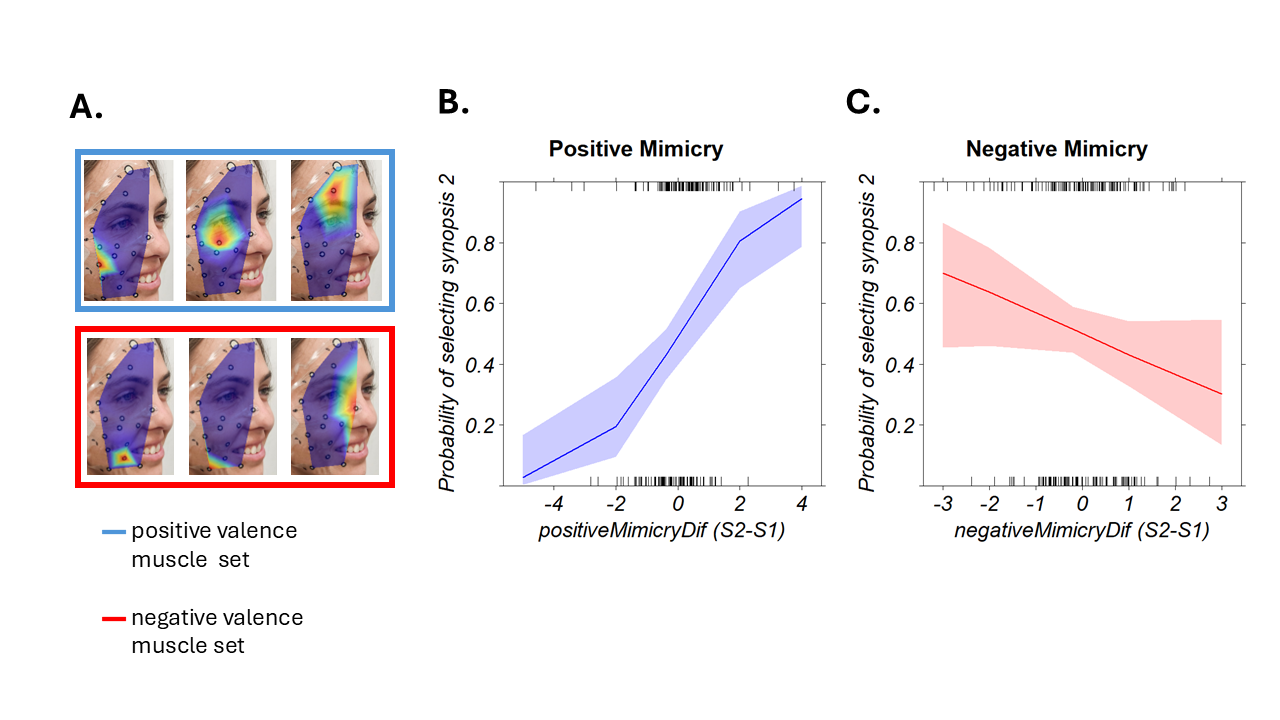Your Face Reveals What You Like: How Mimicry Predicts Preferences
Published in Bioengineering & Biotechnology, Neuroscience, and Behavioural Sciences & Psychology
Have you ever noticed yourself smiling when someone across from you smiles, or furrowing your brow when they look concerned? This automatic mirroring of facial expressions, known as facial mimicry, is so ubiquitous in our social lives that we rarely stop to think about what it means. Is it just a reflexive motor response, or does it serve a deeper function in how we navigate social interactions and make decisions?
In our study, we set out to explore whether facial mimicry could reveal something fundamental about our preferences. The question that drove us was deceptively simple: When you're listening to someone describe different options, does the degree to which you mimic their expressions predict which option you'll ultimately choose?
We tested this by pairing participants in a simple task: one person (the reader) read aloud two short movie synopses, while the other (the listener) watched and listened. After hearing both stories, the listener chose which one they preferred.

The experimental design – Each dyad went through a calibration phase, reading phase where they each read aloud two pairs of synopses and then switched places, and listening phase where they both listened to four pairs of movie synopses pre-recorded by an actress. Illustrations in the "reading" and "listening" phases were adapted from Vecteezy.com
Beyond Automatic Contagion
Classic theories have long viewed facial mimicry as a low-level, reflexive mechanism—essentially an automatic contagion of emotion that happens without conscious thought or purpose. However, recent frameworks have challenged this view, suggesting that mimicry is far more sophisticated: a socially contextualized behavior that responds to our goals and the situations we find ourselves in.
Our findings add compelling evidence to this newer perspective. We discovered that facial mimicry significantly predicted which synopsis participants preferred during dyadic interactions. Remarkably, participants tended to choose the synopsis during which they showed greater mimicry of muscles associated with positive expressions. What makes this particularly intriguing is that participants were explicitly instructed to express their personal preferences, independent of any social evaluation. This suggests that mimicry wasn't just about being polite or building rapport—it served as an implicit cue of genuine agreement with the content.
The Power of Mimicry Over Expression
One might assume that simply showing more positive facial expressions would predict preferences. Interestingly, that's not what we found. While facial expressions alone were not significant predictors of listeners' choices, mimicry was. This makes sense when you consider our stimulus design: we intentionally selected moderately engaging synopses that were closely matched in interest level within each pair. In such a naturalistic and relatively neutral setting, the act of mimicking another person's expressions proved more informative than the expressions themselves.
This finding aligns with previous research showing that for less amusing stimuli, facial expressions alone don't reliably predict preferences. It appears that in everyday interactions—where options are often similarly appealing rather than dramatically different—mimicry provides a subtle but powerful signal of our underlying preferences.
When You Can't See the Smile
Perhaps the most surprising finding emerged when participants listened to pre-recorded movie synopses read by an actress they had never met and couldn't see—yet their facial mimicry of her expressions still predicted their preferences. How is this possible?
The answer lies in our remarkable ability to detect emotions through voice alone. Research has consistently shown that humans can reliably identify smiles through vocal cues, and that we unconsciously mimic smiles we hear. Our study demonstrated that this audio-dependent facial mimicry carries genuine communicative value—it's not merely an automatic motor response, but an index of agreement.
The Directional Nature of Mimicry
Building on recent advances in the field, we treated positive and negative facial expressions as separate, directionally specified predictors. While people do mimic both positive and negative expressions, they do so in a strongly context-dependent manner. For instance, mimicking someone's sadness can be an empathic, help-oriented response when contextually appropriate, whereas witnessing disgust might trigger weaker or less spontaneous mimicry.
In our data, mimicry of negative expressions trended toward predicting reduced preference, though this didn't reach statistical significance. Nevertheless, separating positive from negative mimicry was theoretically important and significantly improved our model's performance.

Main results - (A) Facial muscles comprising the positive and negative mimicry sets. (B) Relationship between relative positive mimicry and synopsis choice. The x-axis shows the difference in positive mimicry between synopses (positive values indicate greater mimicry during synopsis 2). The y-axis shows the predicted probability of choosing synopsis 2. Higher positive mimicry during a synopsis significantly predicted preference for that synopsis. (C) Negative mimicry displayed the opposite relationship, with greater negative mimicry associated with reduced preference (although not significantly).
Embodied Decision-Making
How might mimicry influence our preferences? One compelling possibility is that mimicry provides proprioceptive evidence—physical feedback from our own facial muscles—that accompanies and potentially informs the decision process. There's behavioral evidence that facial feedback facilitates emotion recognition through embodied simulation. When you allow or amplify facial feedback, people are better at selecting the correct emotion label; when you constrain or disrupt it, performance suffers.
If choosing an emotion label can be considered a decision, then embodiment might support related social decisions as well—judging whether a smile is genuine, calibrating how affiliative to be in response, and perhaps, as our study suggests, determining what we prefer. When choosing between closely related options, mimicry-related signals might add that crucial bit of embodied evidence that tips the scales.
The takeaway
Ultimately, our findings suggest that facial mimicry is more than just social glue that helps us bond with others. It appears to play an active role in how we form preferences and make decisions. Your face might be revealing what you like before you've fully made up your mind.
The next time you find yourself mirroring someone's smile, remember: your face might not just be being polite. It might be helping you figure out what you think.
Follow the Topic
-
Communications Psychology

An open-access journal from Nature Portfolio publishing high-quality research, reviews and commentary. The scope of the journal includes all of the psychological sciences.
Ask the Editor – Collective decision-making
Got a question for the editor about Experimental Psychology and Social Psychology? Ask it here!
Continue reading announcementRelated Collections
With Collections, you can get published faster and increase your visibility.
Replication and generalization
Publishing Model: Open Access
Deadline: Dec 31, 2025
Intensive Longitudinal Designs in Psychology
Publishing Model: Open Access
Deadline: Mar 31, 2026





Please sign in or register for FREE
If you are a registered user on Research Communities by Springer Nature, please sign in